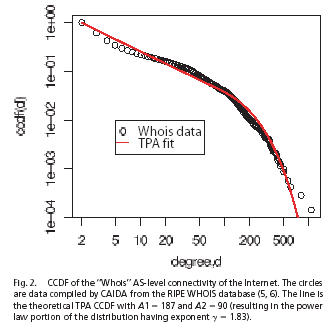The first fax machine had no value. It couldn't send a fax to anyone. It was, from a value perspective, useless.
The second fax machine added value to the first because it now had something which could receive faxes. The third added value to the first two and received value from them in the network as well. As each fax machine came into existence, the value it added was nonlinear. The more fax machines that existed, the more value each of them had.
Many things in life are like that. They don't necessarily follow a Bell curve, they follow something else, a power law distribution, embodied in phrases like "it takes money to make money" and "the rich get richer." It means that large effects in a power law distribution are common.

This idea in computer networks is nothing new, it was just considered to be a property of networks themselves.
U.C. Davis researcher Raissa D'Souza discusses new research on this theory of "preferential attachment" in not just networks, where nodes gain new connections in proportion to how many they already have, but how this can be extruded into other areas as well, in the April 10 issue of the Proceedings of the National Academy of Sciences journal, abstracted here.
"'The rich get richer' makes sense for wealth, but why would it happen for Internet routers?" she asked.
D'Souza and colleagues at Cornell, UCLA and Microsoft Research found that they could tweak the network distance between nodes and the number of connections between them and, by modifying the conditions, they could make preferential attachment - a power-law distribution of the number of connections - stronger or weaker.
In effect they changed the probability that a node with degree ki acquired a link as 
by modifying some of the conditions.
"It's exciting because it shows the origins of something that we had assumed as axiomatic," D'Souza said.
This new framework knowledge could make it possible to optimize many different networks, including social ones. Or even social news sites, like the one you are reading right now.
Note: the other authors on the study, which is published online in the journal Proceedings of the National Academy of Sciences, are Christian Borgs and Jennifer T. Chayes at Microsoft Research, Noam Berger at UCLA and Robert D. Keinberg at Cornell University.





Comments